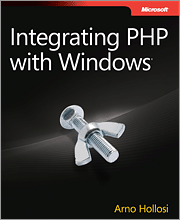Intergating PHP with Windows

Finally, the English version is out. All new and shiny, updated and (a little bit) extended. The book keeps the same basic structure as the German version:
- The first part of the book covers configuring and running PHP on IIS 7.5 and tuning it for best perfomance and security.
- Next: coding against SQL Server, including the important data type conversions between SQL Server and PHP. Full text index, transactions, and PDO are also discussed.
- The third part is about Active Directory, where you learn everything you need to know to manage your users and groups from PHP or use AD to authenticate users.
- The last part covers accessing Exchange Server 2010 through the Exchange Web Services and shows you how you can get PHP and EWS get to talk together. After the initial hurdles are taken, you’re able to send/read email, create contacts, manage appointments, send invitations to meetings etc.
Hope you like the book :o)
You can get it at MS Press@O’Reilly
Sample chapter: Chapter 1 (it’s the first chapter talking about the initial setup and installation)
Here’s the official blurb:
Take your PHP programming skills deep into Windows—and build PHP applications that run efficiently and effectively on an array of Windows technologies. Packed with hands-on exercises, this in-depth guide shows you how to use PHP to interact with Internet Information Services 7.5 (IIS), Microsoft® SQL Server® 2008, Microsoft Exchange Server 2010, and Active Directory®. You’ll quickly learn how to apply best practices for running PHP applications in a Windows environment.
Discover how to:- Use Microsoft SQL Server as the backend database for PHP applications
- Set up full-text search on SQL Server to help users find data quickly
- Improve PHP application performance with IIS caching techniques
- Configure IIS to help secure your PHP applications against attacks
- Manage users and groups in Active Directory with a PHP application
- Create a PHP LDAP browser to search for and view Active Directory data
- Program Exchange Server with PHP, using Exchange Web Services (EWS)
October 29, 2011, Arno Hollosi